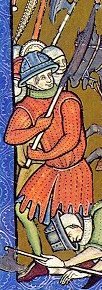Reading
Masters and Slayers by Bryan Davis was a strange experience for me for two reasons. First, I read a digital copy of the galleys. I had never read a "published" novel in digital form before. I think I prefer paper. I tend to do a lot of reading in small bits while I'm waiting in the car or watching something cook. That's hard to do when the book is on your laptop. So, I had to schedule long blocks of time to read
Masters and Slayers, usually at night.
Second,
Masters and Slayers is closely intertwined with Davis'
Starlighter, which I reviewed for the CSFF Blog Tour a few months ago. (For my commentary on
Starlighter, go
here,
here, and
here.) The stories take place in the same worlds and share many of the same characters. The two books could be mashed together into one, albeit very long, novel. The novels differ in their point of view characters.
Masters and Slayers centers on Adrian Masters while
Starlighter tells the story of Jason Masters, Adrian's younger brother. Also, I believe Davis intends
Masters and Slayers for an older audience.
Starlighter is marketed as a YA novel.
Masters and Slayers has a slower pace than
Starlighter with more time for complex character development and it answers a lot of the questions I had after reading
Starlighter. The content is also grittier. For instance, there's some discussion of the breeding program the dragons have established to propagate slaves. You don't have to read
Starlighter first to follow
Masters and Slayers. Many parts of the early chapters are a retelling of the material from
Starlighter from a different character's point of view. This made for a strange reading experience since I already knew what was going to happen in those scenes, as if I had looked at the writer's notes beforehand. If you have not read either novel and want to read both, I recommend reading
Masters and Slayers, which provides more background material, before
Starlighter.
Masters and Slayers takes place on two planets in the same solar system. (I like the names the dragon's use for the planets so I'll use them.) The dragon's home planet is Starlight while the humans native home is Darksphere. There are multiple portals between the two worlds but the existence and location of these is not well known by the residents of either planet. Approximately one hundred years ago, Magnar, a powerful dragon, crossed from Starlight to Darksphere. He captured some humans and took them back to the dragon planet to become slaves in the pheterone mines. Pheterone is a gas trapped beneath the surface that the dragons need to live healthy lives. It's similar to our natural gas. One of the humans--Uriel Blackstone--escapes, returns to Darksphere, and locks the portal. He tries to rally a force to rescue the humans still on Starlight but most dismiss his story as pure lunacy and the government works to suppress it. Some, however, have faith in Blackstone. Over time, an underground organization known as the Underground Gateway develops with the goal of freeing The Lost Ones, as the slaves are now known. Adrian's brother Frederick has succeeded in finding a portal and crossing over to Starlight and a dragon from Starlight has contacted the underground about acquiring pheterone from Darksphere.
Masters and Slayers follows the journeys of three members of the group--Adrian, Marcelle, and Drexel--as they enter Starlight and attempt to return to Darksphere with at least a few freed slaves.
The plot of
Masters and Slayers is complicated. Drexel enters via a different portal than Adrian and Marcelle, and Drexel does not know for certain if the other two are on Starlight. As one expects in a good story, many of the characters have ulterior motives which add to the plot's thickness. I could spend several pages covering its intricacies. Drexel, for instance, hopes to use the rescue of the Lost Ones to propel himself to high political office in Mesolantrum, the home country of the characters from Darksphere. The motives of Arxad, the dragon who wants to trade for pheterone, are equally complex as he appears torn between loyalty to the dragon species and disgust with the practice of slavery.
Forgive me for not providing a detailed plot summary. I would much rather discuss character and theme. The most interesting characters are not Adrian, Marcelle, and Drexel, but Cassabrie and Arxad. Adrian is an accomplished and admirable warrior. He has a solid sense of right and wrong and tends to act accordingly although he can exercise restraint and patience when needed and recognize the complexities of a situation. One could do well to emulate him. There's nothing wrong with Adrian. Therein lies the problem. Almost all his difficulties are external: trekking through the wilderness, finding the Lost Ones, fighting the dragons. He appears to have only one internal problem. Whom does he love more, Cassabrie or Marcelle? And if he must choose between them, will he choose based on his heart or will he sacrifice his own longings and act out of a sense of chivalry and loyalty. This choice is more complicated than it might first appear. Cassabrie is a disembodied spirit. She was executed by Magnar, who feared her powers to hypnotize dragons. Arxad values her talents; he salvaged and protected her spirit. Cassabrie can dwell within Adrian in a kind of "perfect union." Marcelle is Adrian's childhood friend and fellow warrior. On Darksphere, they appeared destined to someday be together. This inner conflict builds slowly through the story and doesn't reach its first fruition until the novel's climatic scenes.
Marcelle is a skilled fighter but acts impulsively. She is strident, sees the world in black and white terms and acts accordingly without considering circumstances or the ramifications of her actions. When she and Adrian go to a work camp for children, Marcelle, against Adrian's advice, rashly attacks a dragon who whips a child. Adrian comes to her aid to kill the dragon. The consequences of this event soon spiral out of control in ways Adrian and Marcelle never imagined. In another scene, Magnar commands some slaves to subdue Marcelle, threatening to burn their children alive if they don't comply. Marcelle rebukes them: "'If all it takes is a verbal threat to your little ones to turn your backbones into butter, then you can just die and rot here! A real man would fight!'" (p. 400) Marcelle fails to consider the context. She is one warrior against many dragons and the slaves know that Magnar will not hesitate to carry out his threat. Prudence suggests the slaves should save their children and live to fight another day when the odds are better.
Drexel is one of the leaders of the Underground Gateway. He lacks great skill as a warrior but does have a talent for planning and manipulating situations to achieve his goals. Unfortunately, his ambitions for political power have crushed his moral compass and he behaves in such a reprehensible manner that the reader feels no sympathy for him.
Cassabrie and Arxad are mysterious. We never see the story from their viewpoint; their motives are never clear. As stated above, Cassabrie owes a great debt to Arxad for her current state of existence. Arxad appears to feel great sympathy for the plight of the slaves but must act carefully to avoid raising the other dragon's suspicions of his loyalty. Arxad takes care to transport the spirits of "promoted" slaves to the Northlands. Arxad defends the slaves in legal proceedings and insists that laws be followed. And when Adrian's execution is imminent Arxad offers to let Adrian kill him so that Adrian can escape. Arxad is bound by law to stop a condemned prisoner from escaping. Adrian considers accepting Arxad's offer but Cassabrie counsels him against it. The slaves are far better off with Arxad in place to check Magnar's power than with him dead. Cassabrie recognizes Arxad's importance to the slaves and the precarious nature of his position. Both Cassabrie and Arxad are pulled in opposite directions, their loyalties divided. When Cassabrie first dwells within Adrian, experiencing the sensations of again having a body, she tells him that "I am to be your guide, not your mistress" (p. 181). Can we believe her? The phrase is repeated multiple times. As Cassabrie's love for Adrian grows, we recognize that the balance between guide and mistress subtly shifts. Arxad warns Adrian to beware of Cassabrie mesmerizing abilities and Adrian wisely heeds the advice.
Before closing out this review, I want to touch on a few themes. Davis depicts a stark contrast between Adrian and Drexel regarding means versus ends. Drexel reveals that he will exercise any means, including sending children to certain death, to achieve his ends which are inherently selfish. For Drexel, saving the Lost Ones is merely a precondition for seizing power though he convinces himself that all he does, all the sacrifices of other lives, is for the greater good. Adrian could not be more different. Saving the Lost Ones is his goal, but he refuses to permit others to die without his intervention to save them, even if such actions ultimately put his goal in jeopardy. For instance, he could have remained hidden at the cattle camp and allowed the dragon to kill several of the children in payment for the death of the dragon that he and Marcelle killed. Such a strategy would have allowed he and Marcelle to continue their efforts. Instead, Adrian offers himself in the place of the children.
In many ways, the dragon society on Starlight mirrors the human society on Darksphere. A corrupt governor rules Mesolantrum and the society is divided between nobles and peasants. The leaders work to suppress anyone or anything that might foment discontent. Talk of rescuing the Lost Ones is forbidden and the Code, an ancient book of wisdom, has been banned. A few citizens, such as Adrian and his father, oppose the government and strive to live according to the Code. On Starlight, Magnar is the counterpart to Mesolantrum's governor while the dragons and slaves mirror the nobles and peasants divide. Like Adrian, Arxad works to restore law and justice to his society.
Whether intentional or not, Davis presents strong, capable warriors in a positive light while those who do not possess fighting skills tend to be victims or scheming villains, usually tainted with a touch of cowardice. The contrast between Adrian and Drexel demonstrates the dichotomy. I find this troubling because not everyone has the physical talents to be a great warrior. Some people are better suited to develop strategy and use cunning to defeat an enemy. Is that sort of talent inherently bad? Drexel uses his skills for ill but might someone use those same skills to achieve positive ends? As we've seen in the case of Marcelle, a little more thinking might go a long way.
I received an advance copy of Masters and Slayers from the publisher through
NetGalley.











